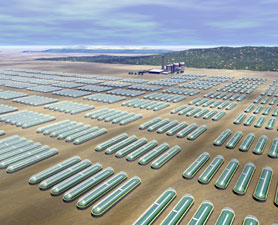
A tech company is developing an alternative to fracking that uses sunlight to produce natural gas.
Several states are drilling for natural gas using a controversial process called hydraulic fracturing or fracking, where chemicals and high-pressure water are used to fracture rock, releasing the gas.
A tech company is developing an alternative to fracking that uses sunlight to produce natural gas.
Several states are drilling for natural gas using a controversial process called hydraulic fracturing or fracking, where chemicals and high-pressure water are used to fracture rock, releasing the gas.
Some environmental activists say the process poses a huge risk to clean drinking water and public health and that the potential for deep underground water contamination used in the shale gas extraction make fracking a huge environmental menace. 
NEWS: Gas Well Fracked a Big Oops
But a tech company says it's developed a way to make natural gas using sunlight that could clean wastewater and alleviate the need for fracking.
"We have sun and waste in abundance," said Tim Young, the CEO of HyperSolar Inc., the Santa Barbara-based company that came up with the process. "The more people around the world consume energy and industrialize their lives, the more wastewater there will be for us to make renewable natural gas."
The process as takes containing millions of nanoparticles. These particles contain semiconductor material and function as self-contained photo electrochemical systems, according to Young. When sunlight hits the particles, an electric charge is generated, driving chemical reactions to form hydrogen at the cathode and oxidizing water at the anode.
From there, the hydrogen is combined with carbon dioxide to form methane, which is the main component of natural gas. The oxidation part of the process cleans the water.
SCIENCE CHANNEL GAME: Power Planets
Young said the nanoparticles can be configured to remove certain materials from the water. Applying HyperSolar's process to hydrogen bromide can produce pure bromide as a byproduct, which can then be marketed for industrial uses.
"Our reactions are designed to occur at normal pressure and temperature," Young said. "This allows our reactor to be very low-cost and very simple, such as a glass vessel." The company's scientific advisers include Eric McFarland, a professor of chemical engineering at the
The company envisions scaling up operations by installing rows of inexpensive reactors on vacant, nonproductive land. The resulting carbon-neutral methane could then be piped into the existing infrastructure for natural gas so that homes, power plants, and businesses could use it, Young said.
HyperSolar has applied for a patent on its process, which Young said is still confidential. Currently the company's nanoparticles still need to be fully developed and tested. They're also working on bringing down the cost of producing the nanoparticles.
"We have much work to do around protecting the catalysts, finding the ideal semiconductor materials, and working on ways to ensure our costs are competitive with traditional energy sources," Young said. He expects the technology to be brought to market in three to five years.
Gary Brudvig is a professor of chemistry, molecular biophysics, and biochemistry at
He's doubtful that HyperSolar's process could realistically compete with fracking because the capacity from wastewater is already pretty limited, he said. "In terms of being able to replace fracking and get us off of fossil fuels use, it certainly won't have the capacity to do that because it's all based on biomass."
NEWS: Shale-Gas Drilling Contaminating Drinking Water
However, Brudvig found the process's potential to clean wastewater compelling. "This would be a way of using the biomass energy content as well as purifying the water," he said. "Wastewater is not going to be useful for anything in the first place, so if they can make something useful out of it, that’s good."
At
"The idea here is that if you can use solar light as the only energy input to produce methane, then it's considered clean. You don't generate waste," he said. Wang added that many research groups are trying to use sunlight for methane production, not just HyperSolar, but they have yet to demonstrate an efficient process to scale.
"If they can actually produce methane specifically with high efficiency and high yield, where solar energy is the only energy input, then that's really the home run," he said.

 Previous page
Previous page Back to top
Back to top







